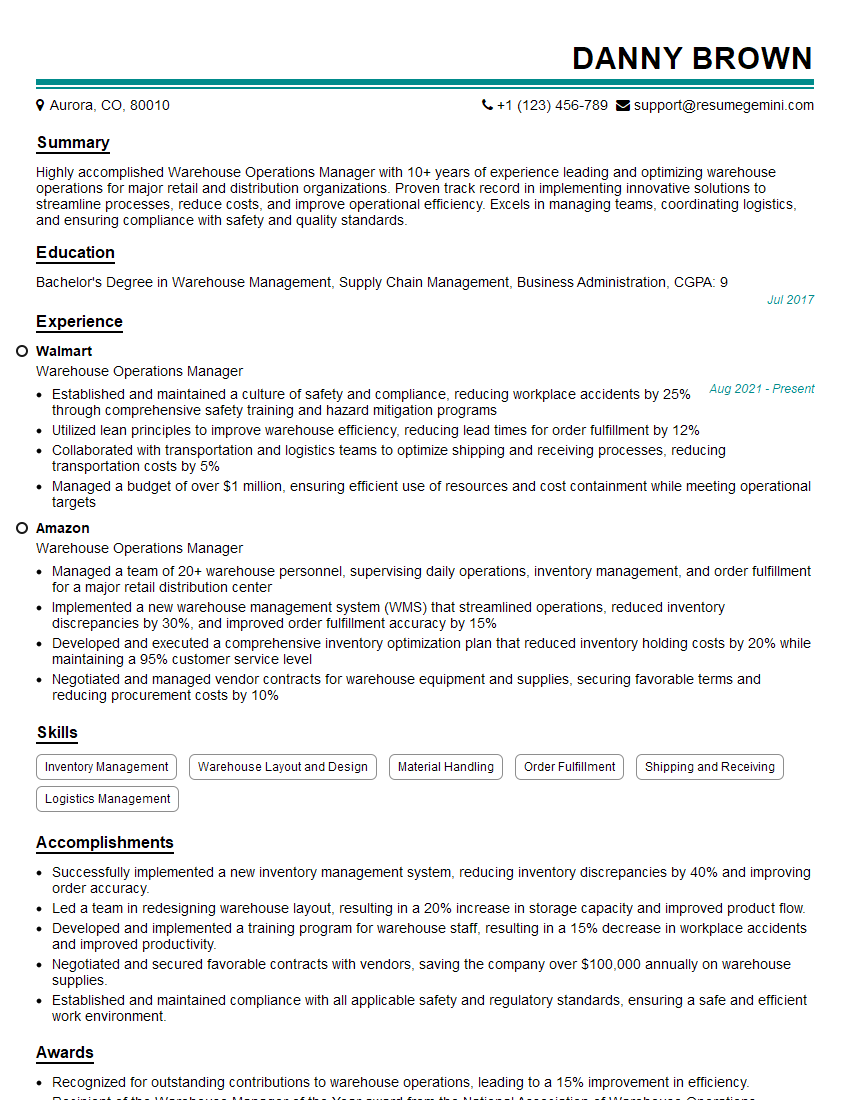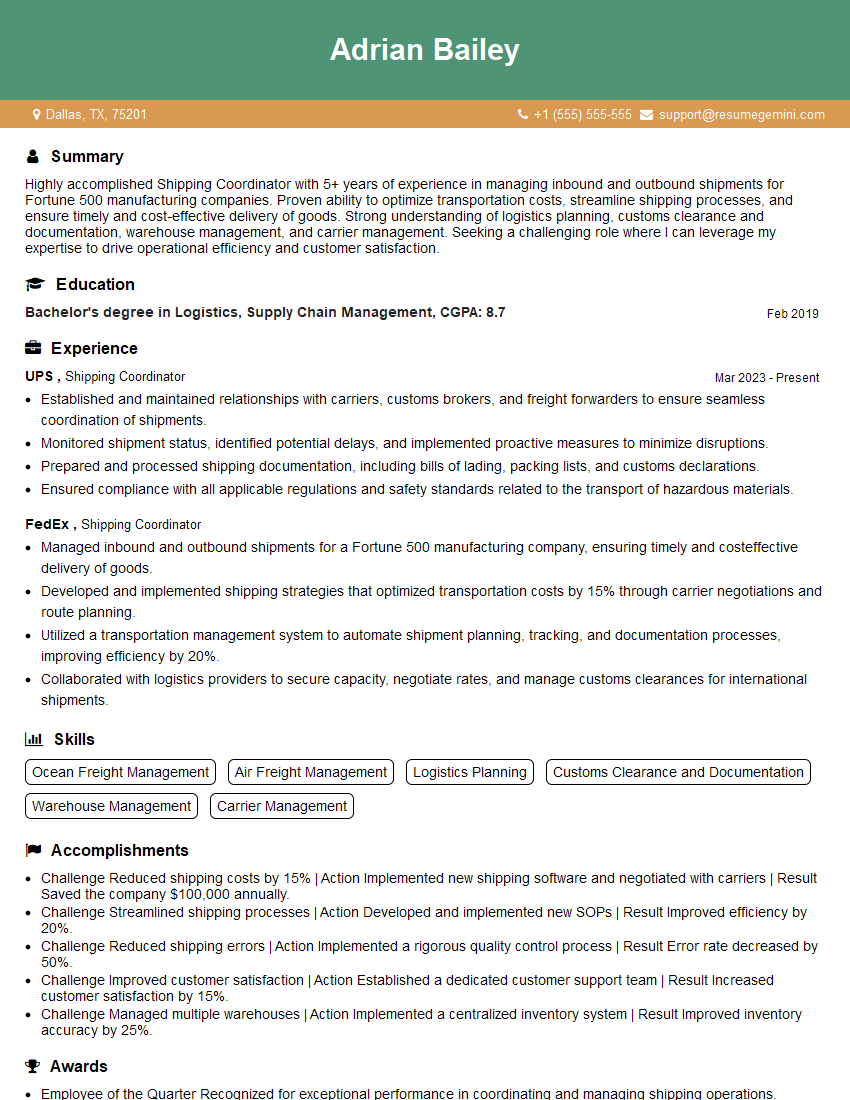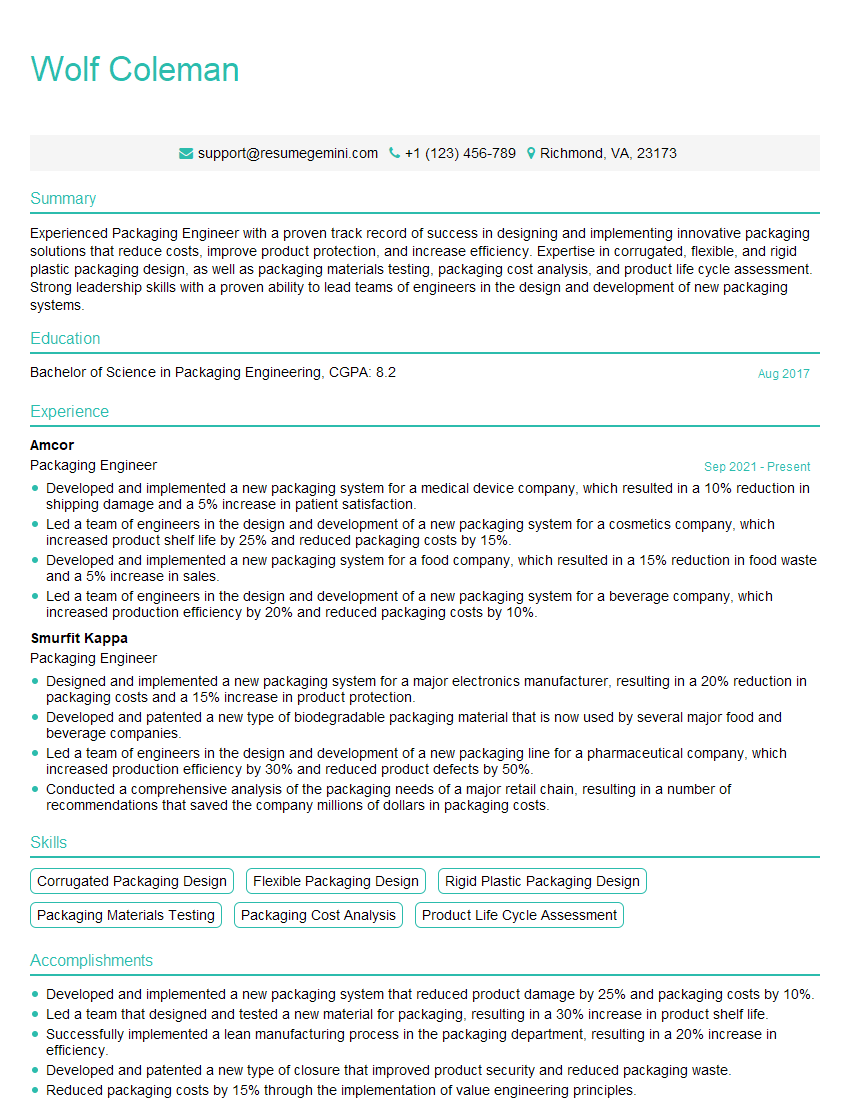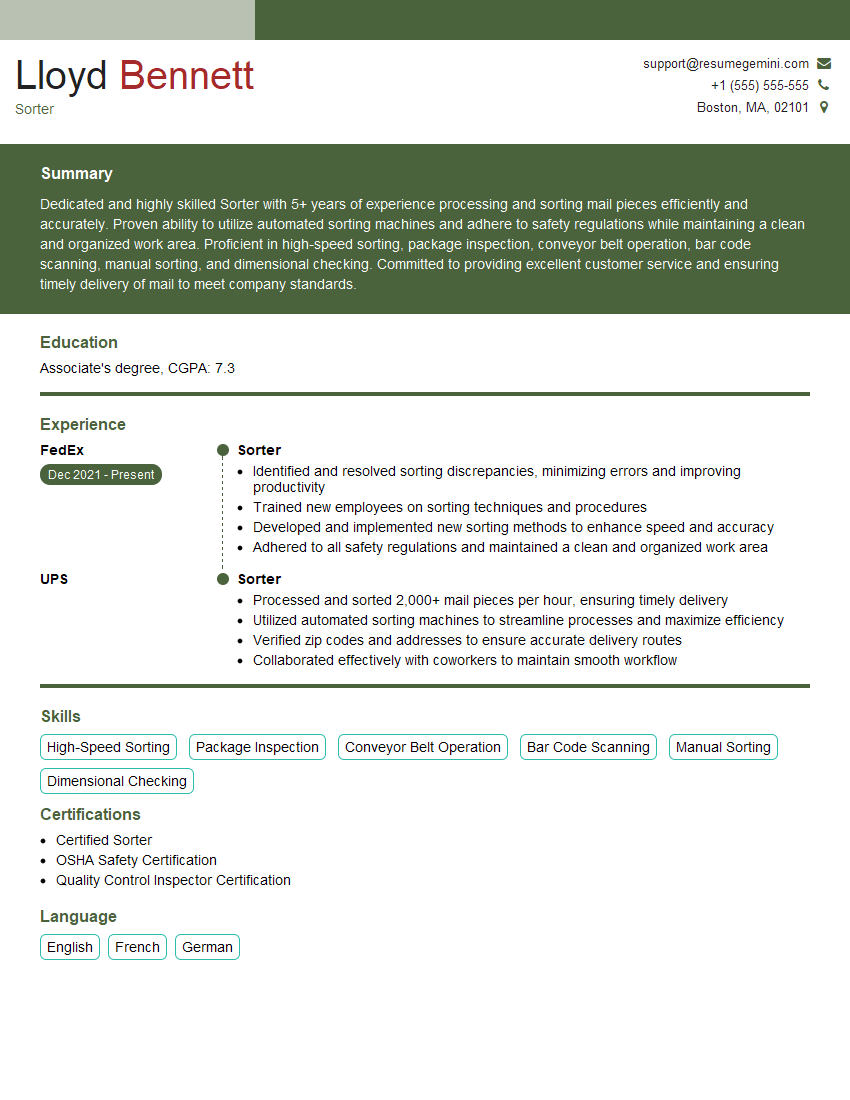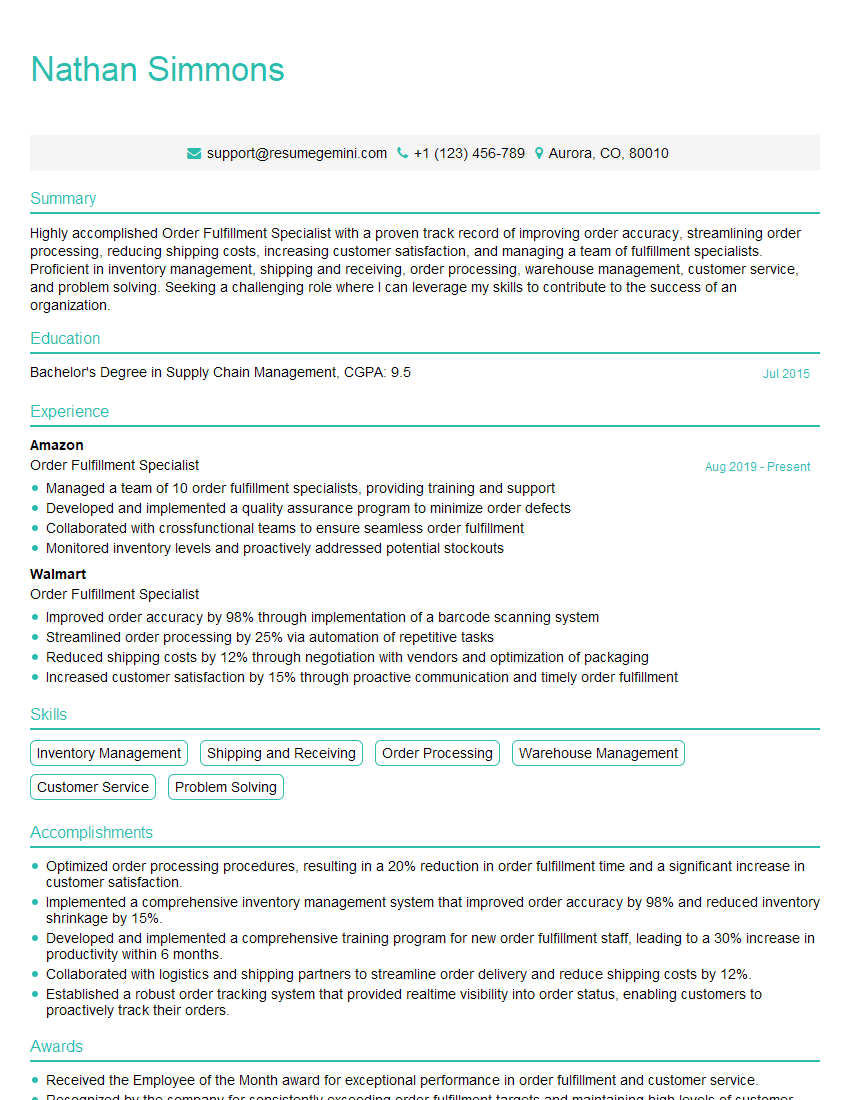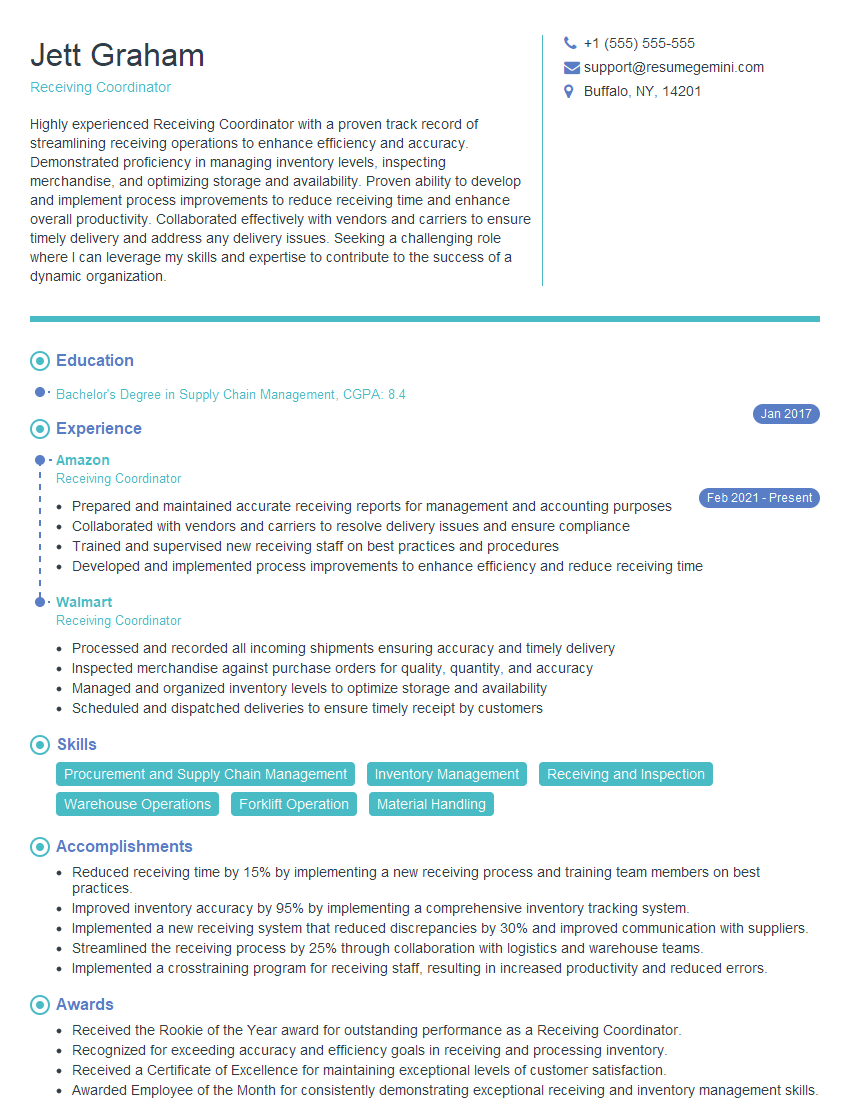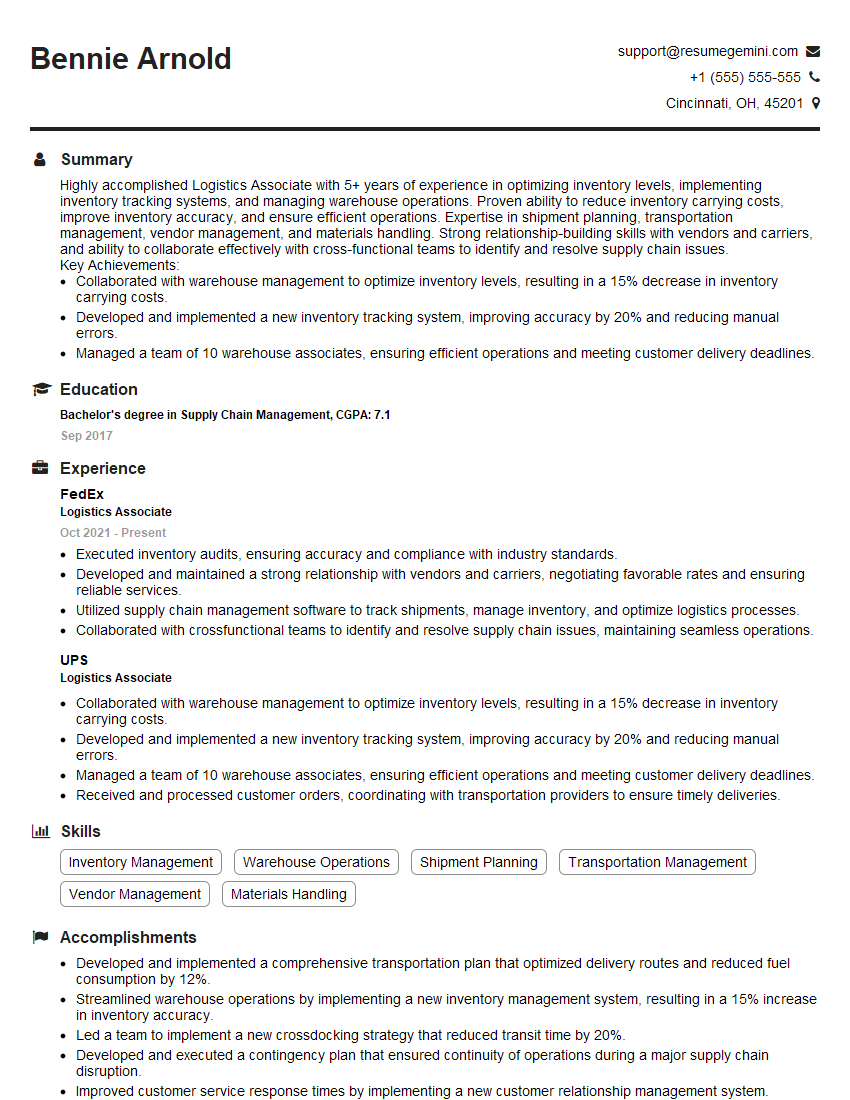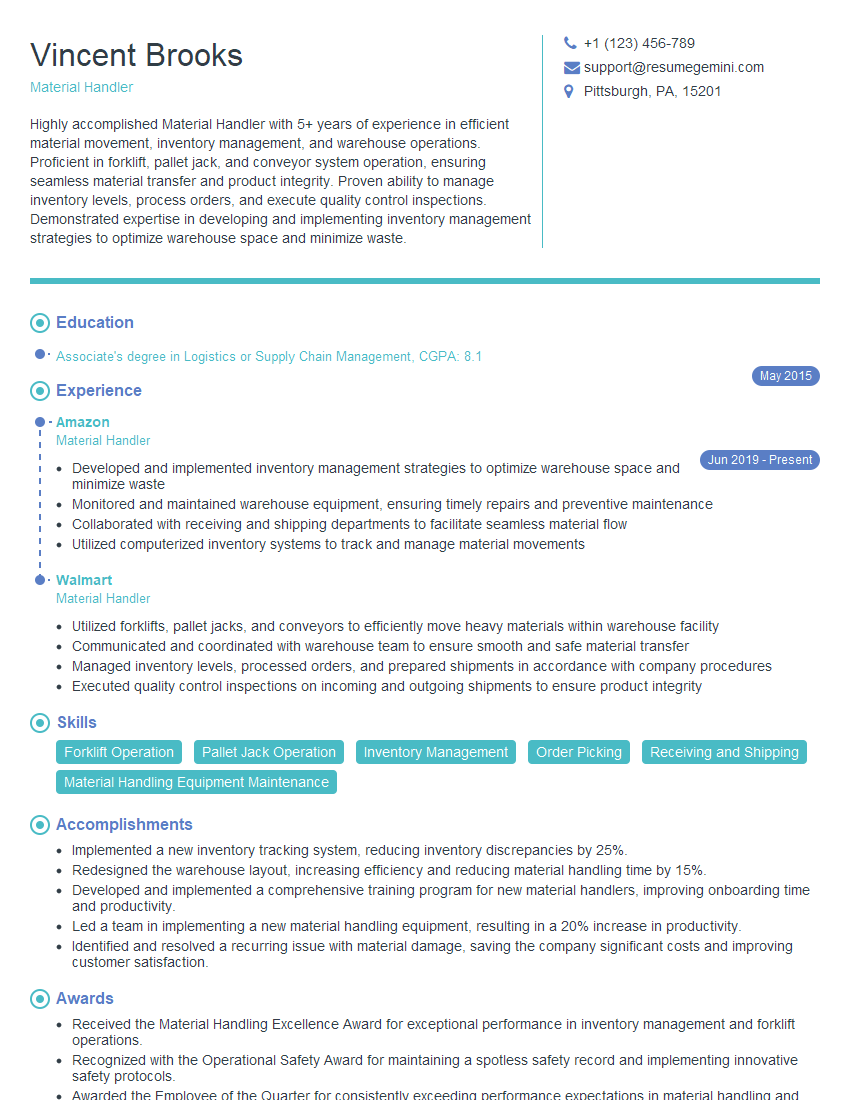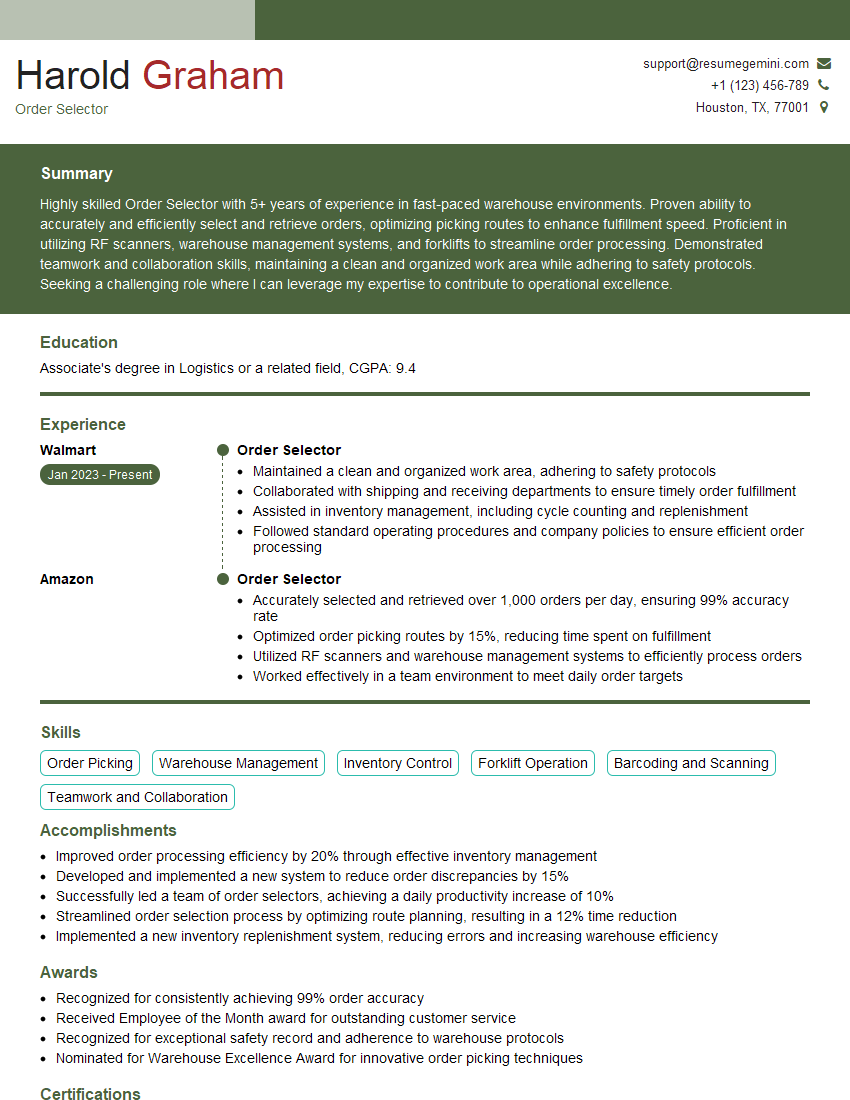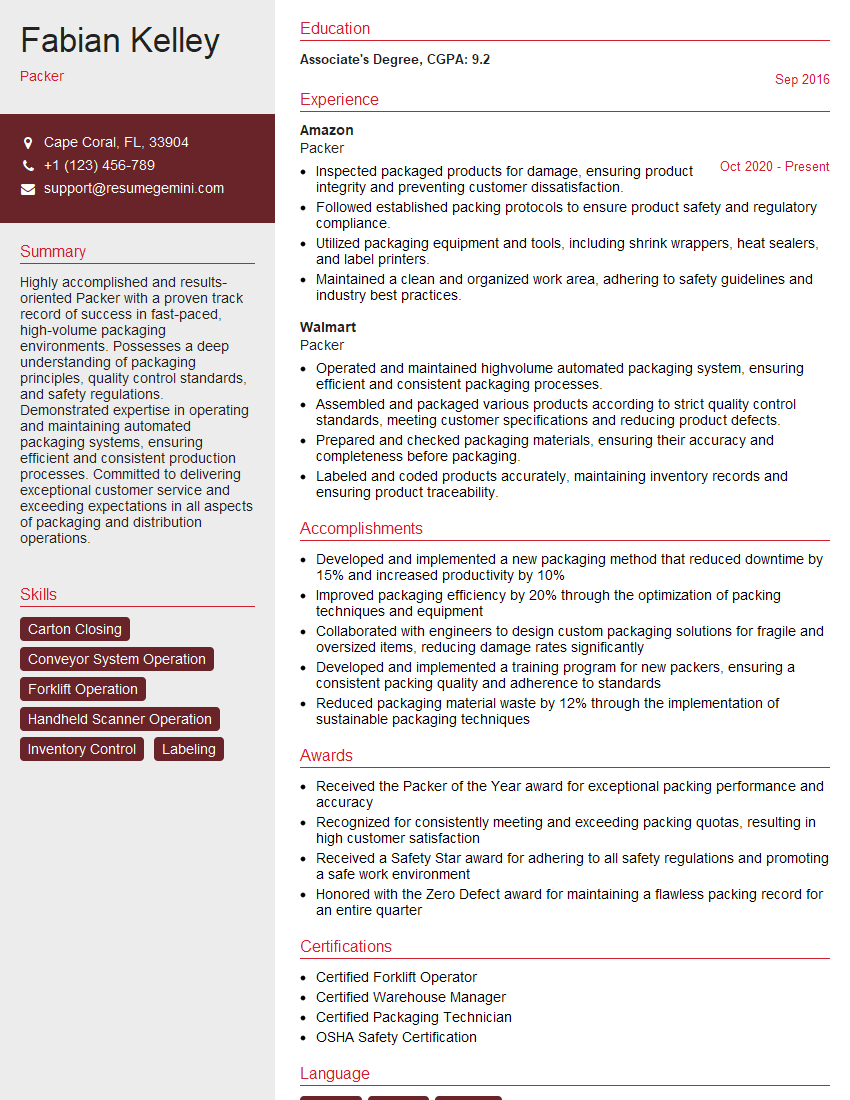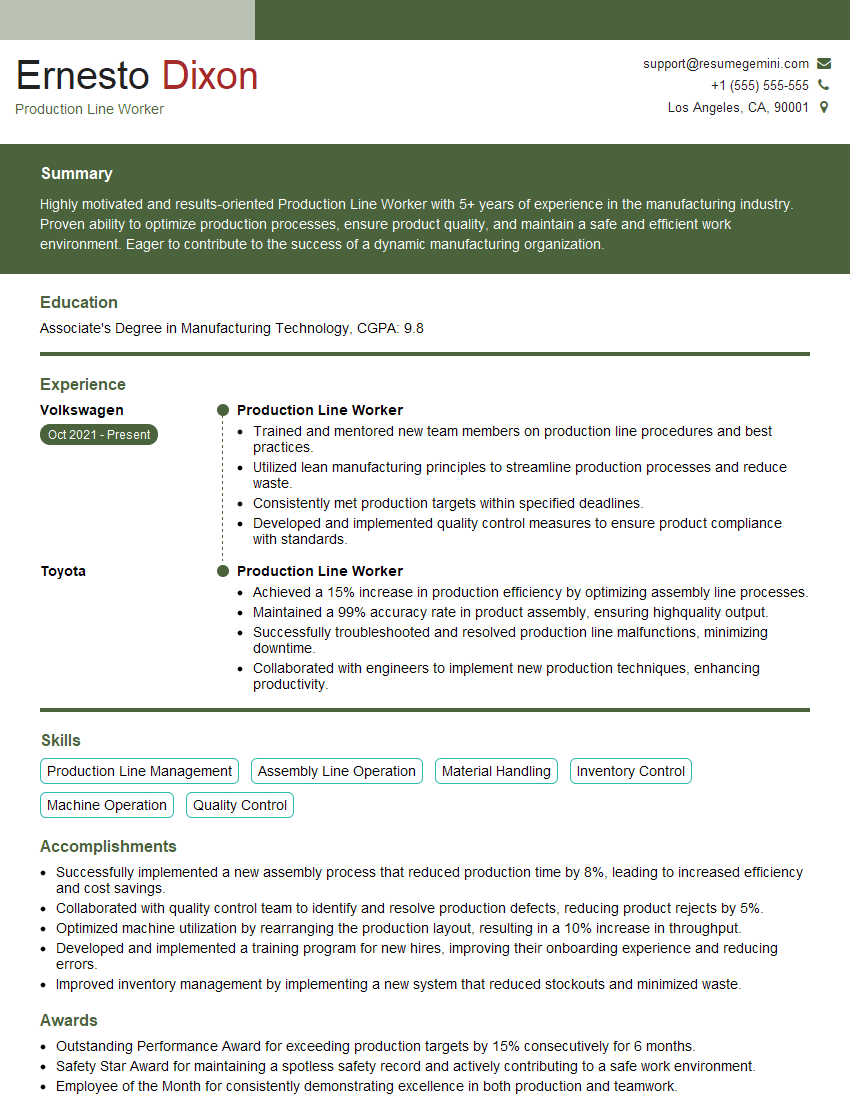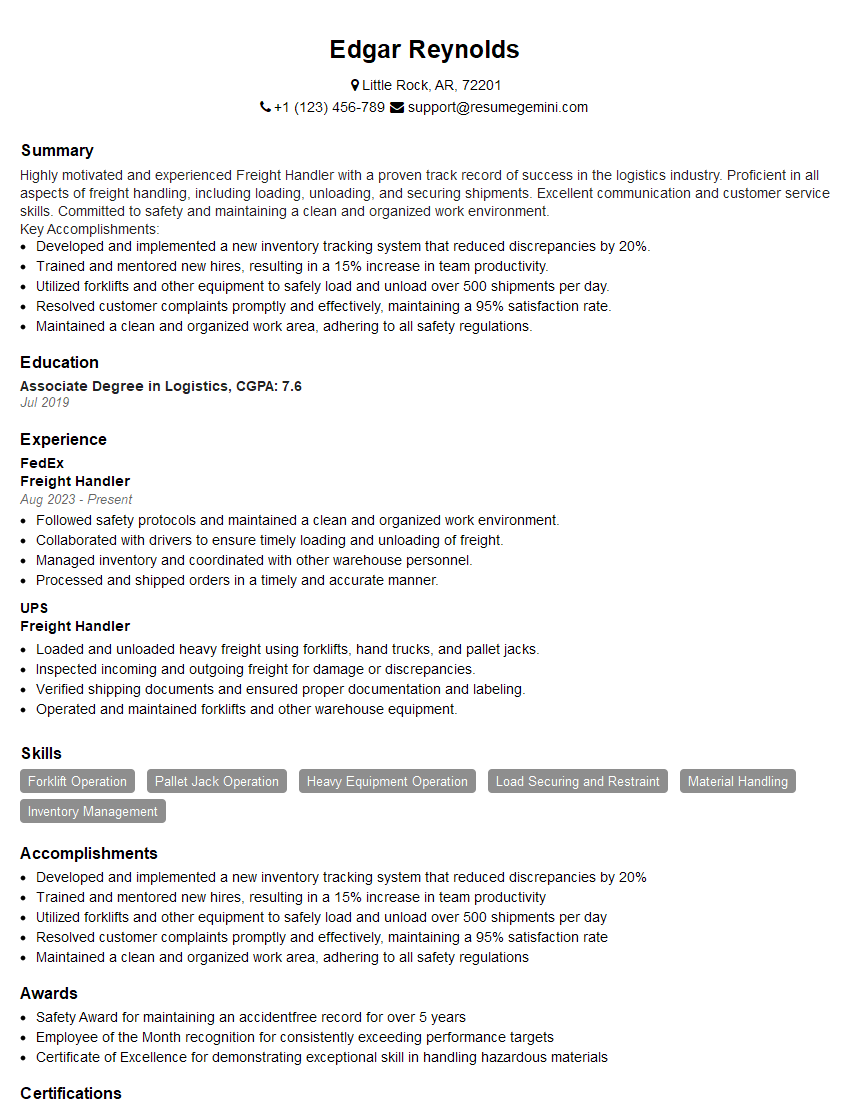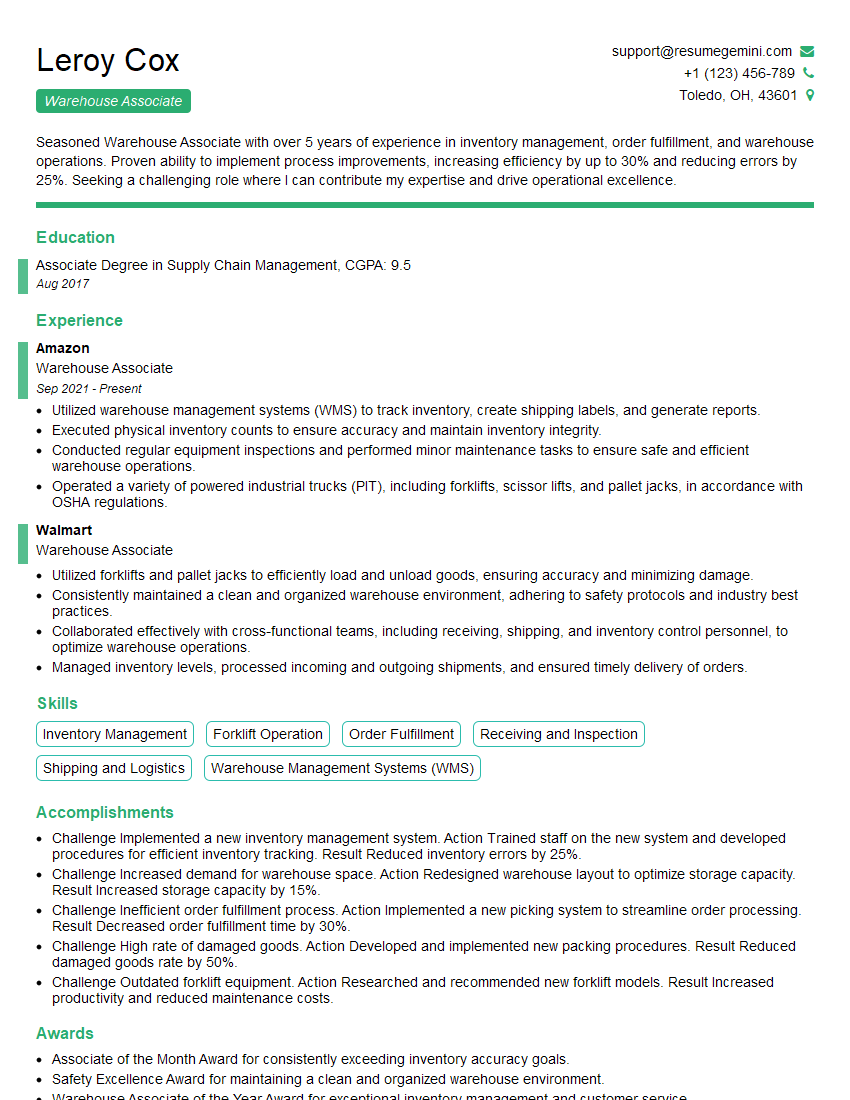Interviews are more than just a Q&A session—they’re a chance to prove your worth. This blog dives into essential Sorting and Packing Methods interview questions and expert tips to help you align your answers with what hiring managers are looking for. Start preparing to shine!
Questions Asked in Sorting and Packing Methods Interview
Q 1. Explain the importance of proper sorting and packing procedures.
Proper sorting and packing procedures are paramount for efficiency, cost reduction, and customer satisfaction. Imagine a warehouse where items are randomly strewn – finding a specific order would be a nightmare! Efficient sorting ensures quick order fulfillment, while careful packing minimizes damage and returns, leading to significant cost savings and improved brand reputation. It’s the backbone of a smoothly functioning supply chain.
Specifically, effective sorting and packing:
- Reduces handling time: Organized items are easier and faster to locate and pack.
- Minimizes shipping costs: Optimized packing reduces wasted space and weight.
- Improves product protection: Proper packing prevents damage during transit, reducing returns and replacements.
- Enhances customer experience: Neatly packed and quickly shipped orders create positive customer impressions.
- Increases warehouse efficiency: Streamlined processes optimize space utilization and employee productivity.
Q 2. Describe different sorting methods and their applications.
Numerous sorting methods exist, each suited to different situations. The choice depends on factors like the number of items, the type of items, available resources, and the desired level of sorting accuracy.
- Bubble Sort: Simple but inefficient for large datasets. It repeatedly steps through the list, compares adjacent elements and swaps them if they are in the wrong order. Great for educational purposes or very small lists.
- Merge Sort: Efficient and widely used. It divides the unsorted list into n sublists, each containing one element, then repeatedly merges sublists to produce new sorted sublists until there is only one sorted list remaining. Excellent for large datasets because it’s a divide-and-conquer approach.
- Quick Sort: Another efficient algorithm that uses a divide-and-conquer approach. It selects a ‘pivot’ element and partitions the other elements into two sub-arrays, according to whether they are less than or greater than the pivot. The sub-arrays are then recursively sorted. Often faster than Merge Sort in practice, but its worst-case performance can be poor.
- Insertion Sort: Simple and efficient for small datasets or nearly sorted data. It iterates through the array and inserts each element into its correct position within the already sorted part of the array. Great for small lists or optimizing nearly sorted data.
In a warehouse setting, I might use a combination of methods. For example, I could use a conveyor belt system to initially sort items by broad categories (e.g., clothing, electronics), and then employ manual sorting within each category for more specific order fulfillment.
Q 3. What are the key factors to consider when choosing a packing material?
Selecting the right packing material is crucial for product protection and cost-effectiveness. Several factors influence this choice:
- Product fragility: Fragile items require more robust packaging, such as bubble wrap, foam inserts, or custom-fit boxes. Conversely, sturdy items need less protective packaging.
- Product size and weight: The packaging must securely contain the item and prevent shifting during transit. Larger and heavier items may need reinforced boxes or additional bracing.
- Environmental considerations: Using sustainable and recyclable materials is increasingly important, reflecting growing consumer concern and environmental regulations.
- Cost: Balancing protection needs with cost-effectiveness is key. The most expensive material isn’t always the best choice. A balance of protection and cost must be reached.
- Shipping method: The chosen packaging should be compatible with the shipping method, accommodating handling and transit conditions.
For example, I would use corrugated cardboard for sturdy products, while delicate electronics might need custom foam inserts inside a double-walled box, sealed with tamper-evident tape.
Q 4. How do you ensure efficient product handling during sorting and packing?
Efficient product handling hinges on well-defined processes and appropriate technology. It’s all about minimizing unnecessary movements and preventing damage.
- Conveyor systems: These automate the movement of items, reducing manual handling and potential damage.
- Ergonomic workstations: Designing workstations to minimize strain on employees improves efficiency and reduces injury risk.
- Clear labeling and identification: Precise labeling guides items through the sorting and packing process, preventing errors and misplacements.
- Trained personnel: Employees should be trained in safe handling techniques and proper packing procedures.
- Quality control checkpoints: Regular checks throughout the process identify and correct errors before they affect the final product.
For example, implementing a bar code scanning system ensures that every item is correctly identified and routed, minimizing errors and improving the overall efficiency of the system.
Q 5. Explain your experience with different types of packaging.
My experience spans a variety of packaging types, each with its strengths and weaknesses. This experience allows for informed decisions based on the specific needs of the product and the shipping requirements.
- Corrugated cardboard boxes: A cost-effective and widely used option, ideal for many products.
- Poly bags: Lightweight and inexpensive, suitable for non-fragile items.
- Bubble wrap: Excellent cushioning for fragile items, reducing the risk of damage during transit.
- Foam inserts: Customizable protection for delicate or oddly shaped items.
- Pallet shipping: For bulk shipments, pallet-based shipping offers a cost-effective way to transport many items simultaneously.
- Specialized packaging: I’ve worked with specialized packaging such as insulated containers for temperature-sensitive items and custom wooden crates for heavy or oversized items.
In one project, I successfully transitioned a client from standard cardboard boxes to more sustainable, biodegradable alternatives, reducing their environmental impact while maintaining product protection and cost efficiency. This required careful consideration of both the material and design of the packaging.
Q 6. How do you prioritize tasks during peak shipping seasons?
Peak shipping seasons demand meticulous planning and prioritization. It’s crucial to proactively manage resources and adapt processes to meet the increased demand.
- Prioritize high-demand items: Focus on fulfilling orders for the most popular or time-sensitive items first.
- Optimize staffing levels: Ensure sufficient staffing to handle the increased workload. Consider temporary staff or overtime to alleviate pressure.
- Streamline processes: Identify and eliminate any bottlenecks in the sorting and packing processes. This may involve adjusting workflows or implementing automation.
- Proactive communication: Keep customers informed about potential delays or changes in delivery times.
- Data-driven decisions: Use historical data to forecast demand and anticipate potential challenges.
In previous peak seasons, I’ve successfully implemented a tiered prioritization system based on order urgency and product value, ensuring the most important orders were fulfilled first. This minimizes customer dissatisfaction and maximizes efficiency during times of high volume.
Q 7. Describe your experience with inventory management software.
My experience with inventory management software is extensive. I am proficient in using various systems to track inventory levels, manage stock replenishment, optimize warehouse space, and predict future demands. This reduces storage costs, prevents stockouts, and improves overall efficiency.
- Inventory tracking: I’ve utilized systems to track item locations, quantities, and movement within the warehouse.
- Order management: I have experience using software to process orders, generate shipping labels, and manage delivery schedules.
- Reporting and analytics: I’m comfortable using software to generate reports on inventory levels, sales trends, and other key metrics.
- Integration with other systems: I’ve worked with software that integrates with other systems, such as e-commerce platforms and shipping carriers, to streamline the entire process.
In a previous role, I implemented a new inventory management system that reduced stockouts by 15% and improved order fulfillment accuracy by 10%. The transition involved training staff, data migration and careful system setup to minimize disruption.
Q 8. How do you handle damaged or defective products during packing?
Handling damaged or defective products during packing is crucial for maintaining customer satisfaction and avoiding returns. My approach involves a multi-step process:
- Immediate Identification: Upon receiving a product, I visually inspect it for any damage or defects. This includes checking for dents, scratches, cracks, or any inconsistencies in packaging.
- Documentation: Any damage is meticulously documented, including photographs and detailed descriptions. This documentation is crucial for returns and potential supplier communication.
- Segregation: Damaged items are immediately segregated from undamaged products to prevent accidental shipment. I use clearly labeled bins or areas specifically designated for defective goods.
- Appropriate Handling: Depending on the severity of the damage and company policy, damaged items may be repaired, salvaged, returned to the supplier, or disposed of properly. Special packaging might be necessary to prevent further damage during return shipping.
- Quality Control Check: Before the final packing stage, a quality control check ensures that no damaged items have accidentally made it into the shipping process.
For example, during a recent project involving fragile glassware, I implemented a double-boxing system with extra cushioning for added protection, significantly reducing damage during transit. This proactive approach minimizes losses and ensures customer satisfaction.
Q 9. What are some common errors to avoid in sorting and packing?
Common errors in sorting and packing can lead to delays, returns, and unhappy customers. To avoid these, I focus on:
- Incorrect Item Picking: Double-checking order details against the items being picked is paramount. Using a barcode scanner and comparing it against the order ensures accuracy. Failing to do so can lead to shipping the wrong product.
- Insufficient Packaging: Underestimating the fragility of items can result in damage during transit. Appropriate packaging materials—like bubble wrap, peanuts, or custom inserts—are essential to protect the goods.
- Inaccurate Labeling: Incorrect labels on packages can lead to delays or misdeliveries. Clear, accurate labels with the correct address and tracking information are fundamental.
- Poor Organization: A disorganized workspace hampers efficiency and increases the chance of errors. Maintaining a clean, well-organized area ensures streamlined workflow.
- Ignoring Quality Control: Failing to perform a final check before shipment is a critical oversight. This step allows for catching any last-minute mistakes.
For instance, in one instance, we noticed a significant increase in damaged goods. By analyzing the process, we identified insufficient padding as the root cause. We implemented a new standard, using more robust packaging material, and damage rates dropped significantly.
Q 10. How do you ensure accuracy in order fulfillment?
Ensuring accuracy in order fulfillment is a core aspect of my work. My strategies include:
- Verification at Each Step: From order processing to picking, packing, and shipping, I verify each step to ensure accuracy. This layered approach minimizes errors.
- Technology Integration: Using Warehouse Management Systems (WMS) and barcode scanners enables real-time tracking and minimizes human error in picking and packing.
- Double-Checking: Employing a double-checking system, where another team member verifies the contents of a package before shipping, further enhances accuracy. This is particularly useful for high-value or complex orders.
- Feedback Mechanisms: Implementing feedback mechanisms to identify and rectify recurring errors is crucial. Regularly reviewing error reports and implementing corrective measures help improve accuracy over time.
- Training and Documentation: Thorough training and clear, accessible documentation ensure that everyone understands the procedures and protocols for accurate order fulfillment.
For example, implementing a WMS in a previous role resulted in a 20% reduction in order fulfillment errors, highlighting the power of technology in enhancing accuracy.
Q 11. Explain your experience with different barcode and label scanning systems.
I have extensive experience with various barcode and label scanning systems, including:
- Handheld Scanners: I am proficient in using various handheld scanners with different barcode symbologies (e.g., UPC, EAN, QR codes). I understand how to troubleshoot common issues such as connectivity problems and scanner malfunctions.
- Fixed Mount Scanners: Experience with fixed-mount scanners integrated into conveyor systems enhances efficiency in high-volume environments.
- Software Integration: I am familiar with integrating scanning systems with Warehouse Management Systems (WMS) to streamline data entry and tracking.
- Label Printers: I can operate various label printers and configure label formats to ensure accurate and readable labels. I also know how to use different label stock and ribbons.
In a previous role, I implemented a new barcode scanning system that improved order accuracy by 15% and reduced processing time by 10% by integrating the system with the existing WMS.
Q 12. Describe your experience with various types of shipping carriers.
My experience encompasses working with a wide range of shipping carriers, including:
- UPS: Proficient in using UPS online shipping tools and understanding their various service options (e.g., ground, express, international).
- FedEx: Similar experience with FedEx’s online tools and service options, including managing shipping labels and tracking information.
- USPS: Experienced in using USPS services for different package sizes and weights, particularly for domestic and international mail.
- Third-Party Logistics (3PL): I have experience working with 3PL providers, coordinating shipments and managing inventory.
Understanding each carrier’s strengths and limitations, such as transit times, cost structures, and service areas, allows for optimized shipping strategy based on client needs and budget constraints.
Q 13. How do you maintain a clean and organized work area?
Maintaining a clean and organized workspace is essential for efficiency and safety. My approach includes:
- 5S Methodology: I utilize the 5S methodology (Sort, Set in Order, Shine, Standardize, Sustain) to maintain a consistently organized workspace.
- Regular Cleaning: Regular cleaning and tidying of the work area, including sweeping, dusting, and wiping down surfaces, are a routine part of my workflow.
- Designated Areas: Designating specific areas for different tasks, materials, and equipment helps prevent clutter and promotes efficiency.
- Proper Storage: Using appropriate storage containers and shelving helps keep materials organized and readily accessible.
- Waste Management: Proper disposal of packaging materials and waste reduces clutter and maintains a clean environment.
A well-organized area minimizes the risk of accidents, improves efficiency, and contributes to a more pleasant and productive work environment.
Q 14. How do you ensure workplace safety while sorting and packing?
Workplace safety during sorting and packing is a top priority. My approach involves:
- Proper Lifting Techniques: Using proper lifting techniques to prevent back injuries is paramount. This includes bending at the knees and lifting with the legs, not the back.
- Protective Equipment: Utilizing appropriate protective equipment, such as gloves and safety shoes, minimizes the risk of injuries from sharp objects or heavy lifting.
- Hazard Awareness: Maintaining awareness of potential hazards, such as slipping hazards from spilled liquids or tripping hazards from clutter, is essential.
- Ergonomic Design: Using ergonomically designed equipment and workstations minimizes strain and promotes comfortable working conditions.
- Reporting Incidents: Reporting any accidents or near misses immediately allows for prompt investigation and corrective actions to prevent future incidents.
For example, in a previous role, we implemented a safety training program that resulted in a significant reduction in workplace injuries. Prioritizing safety creates a healthier and more productive environment.
Q 15. What is your experience with different warehouse management systems (WMS)?
My experience with Warehouse Management Systems (WMS) spans several leading platforms, including Manhattan Associates, Blue Yonder, and NetSuite WMS. I’m proficient in their core functionalities – inventory management, order fulfillment, and warehouse labor management. I understand how to configure these systems to optimize processes for different warehouse layouts and operational needs. For example, in a previous role, I implemented a new WMS at a distribution center experiencing rapid growth. This involved not only the technical configuration but also extensive training for warehouse staff, resulting in a 20% increase in order fulfillment efficiency within six months. My expertise extends beyond basic usage; I understand how to integrate WMS with other enterprise systems, such as Transportation Management Systems (TMS) and Enterprise Resource Planning (ERP) software, for a seamless end-to-end supply chain.
I’m also familiar with various WMS functionalities, such as:
- Inventory tracking: Using barcode scanning, RFID, or other technologies to maintain accurate inventory records.
- Order management: Processing orders, assigning them to workers, and tracking their progress.
- Warehouse control: Directing the flow of goods within the warehouse, optimizing storage locations, and managing equipment.
- Reporting and analytics: Generating reports on key performance indicators (KPIs) to identify areas for improvement.
Career Expert Tips:
- Ace those interviews! Prepare effectively by reviewing the Top 50 Most Common Interview Questions on ResumeGemini.
- Navigate your job search with confidence! Explore a wide range of Career Tips on ResumeGemini. Learn about common challenges and recommendations to overcome them.
- Craft the perfect resume! Master the Art of Resume Writing with ResumeGemini’s guide. Showcase your unique qualifications and achievements effectively.
- Don’t miss out on holiday savings! Build your dream resume with ResumeGemini’s ATS optimized templates.
Q 16. How do you adapt to changes in order volume or product types?
Adapting to changes in order volume or product types requires a flexible approach and a keen eye for process optimization. Think of it like a conductor of an orchestra: you need to adjust the tempo and instruments to maintain harmony. For instance, during peak seasons (like holidays), I’d leverage the WMS to optimize order processing by prioritizing high-demand items and dynamically adjusting labor allocation. This might involve bringing in temporary staff or implementing overtime schedules. Changes in product types often demand alterations to storage strategies; bulky items require more space and different handling than smaller, lighter ones. This necessitates re-evaluating picking and packing processes, potentially implementing zone picking or batch picking strategies to improve efficiency. For example, when a new, fragile product line was introduced, I implemented additional cushioning and void fill materials and revised packing procedures to minimize damage and improve order accuracy. Data analysis plays a crucial role in identifying bottlenecks and forecasting future needs.
Q 17. Describe your experience with automated sorting and packing equipment.
I have extensive experience with automated sorting and packing equipment, including conveyors, sorters (e.g., cross-belt sorters, push-tray sorters), automated guided vehicles (AGVs), and robotic arms. My experience includes both the operational aspects—troubleshooting, maintenance, and operator training—and the strategic aspects—system selection, integration, and optimization. I’ve worked with systems that utilize barcode scanning, RFID, and vision systems for accurate item identification and routing. For example, I was involved in the implementation of a cross-belt sorter in a large e-commerce warehouse, which significantly reduced the manual labor involved in sorting parcels and improved throughput by over 30%. Understanding the limitations of these systems is also critical; for instance, fragile items might require manual handling even in automated facilities.
Q 18. Explain your understanding of different packing methods (e.g., cushioning, void fill).
Packing methods are crucial for protecting goods during transit. Cushioning protects items from impact and shock. Common cushioning materials include bubble wrap, foam peanuts, air pillows, and corrugated inserts. Void fill prevents shifting and damage caused by movement within the package. Examples include crumpled paper, air pillows, and foam-in-place systems. Beyond these, there are considerations like choosing the right box size; an oversized box leaves too much room for shifting, while an undersized box can crush the contents. The selection depends on the product’s fragility, weight, shape, and shipping distance. For fragile items, I might utilize multi-layered cushioning, or custom-fit inserts for a snug fit. For irregularly shaped items, I’d consider void fill materials to prevent shifting.
Q 19. How do you ensure the security of goods during packing and shipping?
Ensuring goods’ security involves several measures. This starts with secure warehouse practices – access control, surveillance systems (CCTV), and employee training on security protocols. During packing, tamper-evident seals and strong packaging materials are essential. For high-value items, we might use specialized containers or incorporate GPS tracking. Proper labeling with clear destination addresses and handling instructions is vital. Insurance policies are often employed to cover potential losses or damage during transit. Collaboration with reputable shipping carriers who employ their own security measures is also key. Regular audits and checks of our processes are critical to proactively identifying potential vulnerabilities and improving security measures.
Q 20. How familiar are you with weight and dimension restrictions for shipping?
Familiarity with weight and dimension restrictions is critical for cost-effective and compliant shipping. These limitations vary across carriers and shipping methods. Exceeding limits leads to increased shipping costs, delays, or even rejection of packages. I use shipping software and carrier guidelines to ensure compliance. This involves accurately measuring and weighing packages, selecting appropriate packaging materials, and optimizing the package dimensions to minimize wasted space and weight. For example, knowing the dimensional weight (calculated based on package dimensions) is crucial because it often determines the actual shipping cost, even if the physical weight is lower. Staying updated on carrier regulations and using shipping calculators are part of my regular routine.
Q 21. How do you handle discrepancies between order details and the actual products?
Discrepancies between order details and actual products are addressed through a systematic process. First, I’d verify the discrepancy; is it a simple labeling error or a more significant issue? Then, I’d consult the warehouse management system and order tracking information to pinpoint the source of the problem. This may involve checking inventory records, examining picking lists, or reviewing packing slips. If the issue is a picking error, I’d correct it and immediately notify the customer. If the discrepancy is due to an inventory issue, I’d investigate the root cause and adjust inventory counts accordingly. Clear communication with customers is vital, keeping them informed of the situation and resolution steps. Depending on the nature and severity of the discrepancy, I may offer a refund, replacement, or partial refund/replacement.
Q 22. How do you ensure compliance with regulations regarding hazardous materials?
Ensuring compliance with regulations for hazardous materials is paramount in sorting and packing. It involves a multi-step process beginning with proper identification. We utilize the Globally Harmonized System of Classification and Labelling of Chemicals (GHS) and relevant Safety Data Sheets (SDS) to correctly classify each hazardous material. This includes identifying the hazard class (e.g., flammable, corrosive, toxic) and understanding its associated risks.
Next, segregation and packaging are crucial. Hazardous materials are separated based on their compatibility and hazard class, preventing dangerous interactions. Packaging must meet stringent requirements, often involving specialized containers, labels, and markings as outlined in regulations like the IATA Dangerous Goods Regulations for air shipments or the IMDG Code for sea freight. For example, corrosive materials require containers resistant to chemical degradation, while flammable materials necessitate packaging that prevents ignition.
Finally, documentation is key. Every step of handling hazardous materials—from receiving to shipping—must be meticulously documented. This includes the correct completion of shipping papers, declarations, and emergency response information. Regular training for all personnel on hazardous materials handling and relevant regulations is also essential. Failure to comply can result in severe penalties, including fines and legal repercussions.
Q 23. Describe your experience working under pressure and meeting deadlines.
Working under pressure and meeting tight deadlines is a regular part of this role. In one instance, we had to process and ship over 10,000 orders for a major retail client before a crucial promotional event. This required meticulous planning, effective team coordination, and the ability to adapt to unexpected challenges. We prioritized orders based on delivery urgency, optimizing our workflow to maximize efficiency. Through clear communication, delegating tasks appropriately, and leveraging automation tools where possible, we successfully met the deadline and exceeded client expectations. This experience emphasized the importance of proactive problem-solving and the ability to remain calm and focused under pressure.
Q 24. Explain your approach to problem-solving when encountering packing challenges.
My approach to problem-solving in packing challenges is systematic and data-driven. I begin by clearly defining the problem. Is it a space optimization issue? A packaging material shortage? An incompatibility between products and packaging? Once defined, I gather all relevant data, which could include product dimensions, weight, fragility, shipping requirements, and available resources. Then, I brainstorm possible solutions, considering both short-term fixes and long-term improvements. This might involve re-evaluating packing methods, sourcing alternative materials, or redesigning packaging.
For example, if faced with oversized items that don’t fit standard boxes, I might explore using custom-sized boxes or employing specialized packing techniques such as void fill optimization to prevent shifting during transit. I then evaluate each solution based on its feasibility, cost-effectiveness, and impact on efficiency. Finally, I implement the chosen solution, monitor its effectiveness, and make adjustments as needed. Regularly reviewing our processes allows us to identify and address potential problems before they escalate.
Q 25. How do you calculate shipping costs based on weight and dimensions?
Calculating shipping costs involves considering several factors, primarily weight and dimensions. Carriers use dimensional weight (DIM weight) in addition to actual weight to determine the shipping cost. DIM weight takes into account the space a package occupies on the transportation vehicle. The formula often used is:
DIM Weight = (Length x Width x Height) / Dimensional Factor
The dimensional factor varies depending on the carrier. For example, a factor of 166 might be used for a particular carrier, meaning the package dimensions are multiplied and then divided by 166 to arrive at the DIM weight in pounds or kilograms. The higher of the actual weight and the DIM weight is then used to calculate the shipping cost. Other factors influencing costs include destination, shipping speed (e.g., ground, express), and any additional services like insurance or special handling.
In practice, I utilize shipping software that automatically calculates these values based on entered package dimensions and weight, pulling the dimensional factor from the carrier’s rate information. This minimizes errors and saves time. In scenarios with unusual dimensions or irregular shapes, I’ll manually calculate the DIM weight and use this to obtain accurate quotes from multiple carriers.
Q 26. What metrics do you use to measure efficiency in sorting and packing?
Several key metrics help measure efficiency in sorting and packing. Order fulfillment rate indicates the percentage of orders processed and shipped correctly and on time. A high rate reflects smooth operations. Picking accuracy measures the correctness of items selected for each order, reducing errors and returns. Packing accuracy focuses on the quality of packing, minimizing damage and ensuring proper labeling. Throughput rate measures the number of units or orders processed per hour or per day, demonstrating overall productivity. Space utilization considers the efficient use of warehouse space, reducing storage costs and improving workflow. We monitor all these metrics regularly to identify areas for improvement, track performance against benchmarks, and make data-driven decisions.
Q 27. Describe your experience with using handheld scanners and RF devices.
I have extensive experience using handheld scanners and RF (Radio Frequency) devices. These tools are integral to modern sorting and packing operations, increasing accuracy and speed. Handheld scanners enable efficient barcode scanning for real-time inventory tracking and order fulfillment. This ensures the correct items are picked and packed for each order. RF devices allow for wireless communication with warehouse management systems (WMS), updating order status and inventory levels in real-time. I’m proficient in using various models and operating systems, from basic barcode scanners to sophisticated RF devices with integrated data capture functionalities.
For instance, in a previous role, we transitioned from a paper-based system to a fully integrated WMS using RF scanners. This dramatically improved order accuracy, reduced picking times, and significantly eased the process of managing inventory. Training new staff on the use of these devices is also something I’m comfortable with and a part of my usual workflow.
Q 28. How do you maintain accurate records of sorted and packed items?
Maintaining accurate records is crucial for traceability, accountability, and efficient inventory management. We employ a robust system that integrates manual and automated processes. Each item is tracked from the moment it arrives at the warehouse to when it leaves as part of a shipment. This involves using barcodes and RFID tags, which are scanned at various stages of the sorting and packing process. This data is then recorded in our WMS, providing a real-time overview of inventory and order status.
In addition to electronic records, we maintain physical records, including packing lists and shipping documents, which serve as backup and are critical in case of discrepancies. Regular audits of both electronic and physical records ensure data integrity and adherence to company procedures. This systematic approach minimizes errors and provides a clear audit trail for all sorted and packed items. This detailed approach is fundamental for efficient inventory management, accurate order fulfillment, and adherence to regulatory requirements.
Key Topics to Learn for Sorting and Packing Methods Interview
- Order Fulfillment Processes: Understanding the entire flow from receiving inventory to dispatching orders, including various stages and their impact on efficiency.
- Sorting Algorithms: Exploring different sorting techniques (e.g., bubble sort, insertion sort, merge sort) and their application in optimizing packing and order fulfillment. Consider their efficiency in different scenarios (e.g., large vs. small datasets).
- Packing Optimization Techniques: Learn how to maximize space utilization and minimize packaging materials while ensuring product safety and integrity. Explore concepts like cubic packing and algorithms for efficient box selection.
- Inventory Management Systems (IMS): Familiarize yourself with how IMS software supports sorting and packing operations, including integration with warehouse management systems (WMS).
- Material Handling Equipment: Understand the use of conveyors, sorters, and other equipment in a warehouse environment, and their impact on sorting and packing efficiency. Be prepared to discuss safety protocols and operational procedures.
- Quality Control and Assurance: Learn about procedures and techniques to ensure accuracy in order fulfillment, damage prevention, and compliance with industry standards.
- Safety Procedures and Regulations: Demonstrate an understanding of warehouse safety protocols, proper lifting techniques, and compliance with relevant health and safety regulations.
- Problem-Solving and Troubleshooting: Be ready to discuss how you would approach and resolve common issues in sorting and packing, such as order discrepancies, damaged goods, or equipment malfunctions.
Next Steps
Mastering Sorting and Packing Methods is crucial for career advancement in logistics, warehousing, and supply chain management. These skills are highly sought after, and demonstrating proficiency will significantly enhance your job prospects. Creating a strong, ATS-friendly resume is vital in today’s competitive job market. To ensure your resume effectively showcases your abilities, we encourage you to leverage ResumeGemini, a trusted resource for building professional resumes. ResumeGemini provides examples of resumes tailored to Sorting and Packing Methods to guide you in crafting a compelling application that highlights your skills and experience.
Explore more articles
Users Rating of Our Blogs
Share Your Experience
We value your feedback! Please rate our content and share your thoughts (optional).
What Readers Say About Our Blog
Hi, I represent an SEO company that specialises in getting you AI citations and higher rankings on Google. I’d like to offer you a 100% free SEO audit for your website. Would you be interested?
good




